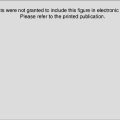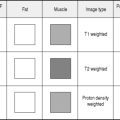Chapter 16 Thyroid and parathyroids
Methods of imaging the thyroid and parathyroid glands
3.
Computed tomography (CT)
4.
Magnetic resonance imaging (MRI)
ULTRASOUND OF THYROID
Indications
2.
Suspected thyroid tumour
3.
‘Cold spot’ on radionuclide imaging
4.
Suspected retrosternal extension of thyroid
5.
Guided aspiration or biopsy.
Patient preparation
None.
Equipment
5–10-MHz transducer. Linear array for optimum imaging.
Technique
The patient is supine with the neck extended. Longitudinal and transverse scans are taken of both lobes of the thyroid. The isthmus is imaged in a transverse scan as it crosses anterior to the trachea. If there is retrosternal extension, angling downwards and scanning during swallowing may enable the lowest extent of the thyroid to be visualized.
ULTRASOUND OF PARATHYROID
The normal parathyroid glands are not visualized at US because of their small size and similar texture to surrounding tissue. US is performed with a 5–10 MHz transducer for the detection of parathyroid adenoma, hyperplasia and carcinoma and to guide aspiration or biopsy.
Further reading
American Institute of Ultrasound in Medicine. AIUM guideline for the performance of thyroid and parathyroid ultrasound examination. J. Ultrasound Med.. 2003;22(10):1126-1130.
Gritzmann N., Koischwitz D., Rettenbacher T. Sonography of the thyroid and parathyroid glands. Radiol. Clin. North Am.. 2000;38(5):1131-1145.
Solbiati L., Osti V., Cova L., et al. Ultrasound of thyroid, parathyroid glands and neck lymph nodes. Eur. Radiol.. 2001;11(12):2411-2424.
CT and MRI of Thyroid and Parathyroid
In thyroid disease CT or MRI are indicated:
1.
for assessment of a thyroid mass over 3 cm in size
2.
for differentiation of thyroid tissue from adjoining neck mass
3.
in staging of known thyroid malignancy
4.
to assess extension of substernal goitre.
As a result of its iodine content, normal thyroid is hyperdense relative to adjacent soft-tissue structures on non-contrast enhanced CT. Unless otherwise contraindicated, CT of thyroid is routinely performed with intravenous (i.v.) contrast. Particular care must be taken in the administration of iodinated i.v. contrast to hyperthyroid patients (see Chapter 2) and in the timing of any subsequent radionuclide thyroid imaging.
In parathyroid disease, CT and MRI are used:
1.
to detect parathyroid adenoma in primary hyperparathyroidism
2.
in patients with persistent or recurrent hyperparathyroidism following neck exploration.
Further reading
Gotway M.B., Higgins C.B. MR imaging of the thyroid and parathyroid glands. Magn. Reson. Imaging Clin. N. Am.. 2000;8(1):163-182.
.
Weber A.L., Randolph G., Aksoy F.G. The thyroid and parathyroid glands. CT and MR imaging and correlation with pathology and clinical findings. Radiol. Clin. North Am.. 2000;38(5):1105-1129.
Radionuclide Thyroid Imaging
Indications
1.
Evaluation of likely malignancy of thyroid nodules
2.
Assessment of goitre including retrosternal extension
3.
Assessment of thyroid uptake prior to radio-iodine therapy
4.
Assessment of neonatal hypothyroidism
15.
To locate ectopic thyroid tissue, e.g. lingual or in a thyroglossal cyst
6.
Evaluation of thyroiditis.
Radiopharmaceuticals
1.
99mTc-pertechnetate, 80 MBq max (1 mSv ED). Pertechnetate ions are trapped in the thyroid by an active transport mechanism, but are not organified. Cheap and readily available, it is an acceptable alternative to
123I.
2.
123I-sodium iodide, 20 MBq max (4 mSv ED). Iodide ions are trapped by the thyroid in the same way as pertechnetate, but are also organified, allowing overall assessment of thyroid function. The agent of choice, but
123I is a cyclotron product and is, therefore, relatively expensive with limited availability.
131I-sodium iodide can also be used for imaging but is associated with a significantly higher radiation dose, so is generally used in the context of whole-body imaging post
131I ablation.
Equipment
2.
Pinhole, converging or high-resolution parallel hole collimator.
Patient preparation
None, but uptake may be reduced by antithyroid drugs, iodine-based preparations and radiographic iodinated contrast media.
Technique
99mTc-pertechnetate
1.
I.v. injection of pertechnetate
2.
After 15 min, immediately before imaging, the patient is given a drink of water to wash away pertechnetate secreted into saliva
3.
Start imaging 20 min post injection when the target-to-background ratio is maximum
4.
The patient lies supine with the neck slightly extended and the camera anterior. For a pinhole collimator, the pinhole should be positioned to give the maximum magnification for the camera field of view (usually 7–10 cm from the neck)
5.
The patient should be asked not to swallow or talk during imaging. An image is acquired with markers on the suprasternal notch, clavicles, edges of neck and any palpable nodules.
123I-sodium iodide
The technique is similar to that for pertechnetate except:
1.
sodium iodide may be given i.v. or orally
2.
imaging is performed 3–4 h after i.v. administration or 24 h after an oral dose
3.
a drink of water is not necessary, since
123I is not secreted into saliva in any significant quantity.
Films
200 kilocounts or 15 min maximum:
2.
LAO and RAO views as required, especially for assessment of multinodular disease
3.
Large field of view image if retrosternal extension or ectopic thyroid tissue is suspected.
Analysis
The percentage thyroid uptake may be estimated by comparing the background-subtracted attenuation-corrected organ counts with the full syringe counts measured under standard conditions before injection.
Additional techniques
1.
Whole-body
131I imaging is often performed after thyroidectomy and
131I ablation for thyroid cancer to locate sites of metastasis
2.
Perchlorate discharge tests can be performed to assess possible organification defects, particularly in congenital hypothyroidism.
1
Other techniques
Metastatic thyroid cancer can be evaluated using diagnostic 123I or therapeutic 131I whole body scans as above. When these scans are negative, but serum thyroglobulin is raised FDG PET is often positive.2
Metastatic medullary carcinoma of the thyroid can be imaged with either pentavalent DMSA, indium-labelled octreotide, MIBG or, more recently, FDG PET. These techniques are discussed in Chapter 11.
References
1 El-Desouki M., Al-Jurayyan N., Al-Nuaim A., et al. Thyroid scintigraphy and perchlorate discharge test in the diagnosis of congenital hypothyroidism. Eur. J. Nucl. Med.. 1995;22:1005-1008.
2 Intenzo C.M., Jabbour S., Dam H.Q., et al. Changing concepts in the management of differentiated thyroid cancer. Semin. Nucl. Med.. 2005;35:257-265.
Further reading
Martin W.H., Sandler M.P., Gross M.D. Thyroid, parathyroid, and adrenal gland imaging. In: Sharp P.F., Gemmell H.G., Murray A.D., editors. Practical Nuclear Medicine. 3rd edn. London: Springer-Verlag; 2005:247-272.
Sarkar S.D. Benign thyroid disease: what is the role of nuclear medicine. Semin. Nucl. Med.. 2006;36(3):185-193.
Radionuclide Parathyroid Imaging
Indications
Pre-operative localization of parathyroid adenomas and hyperplastic glands, usually before second-look surgery.
Radiopharmaceuticals
1.
99mTc-methoxyisobutylisonitrile (MIBI or sestamibi), 500 MBq typical, 900 MBq max (11 mSv ED) and
99mTc-pertechnetate, 80 MBq max (1 mSv ED). Both MIBI and pertechnetate are trapped by the thyroid, but only MIBI accumulates in hyperactive parathyroid tissue. With computer subtraction of pertechnetate from MIBI images, abnormal accumulation of MIBI may be seen. MIBI also washes out of normal thyroid tissue faster than parathyroid, so delayed images (1–4 h) can highlight abnormal parathyroid activity.
2.
99mTc-tetrofosmin (Myoview) can be used as an alternative to MIBI, and is as effective if the subtraction technique is used, but not as good for delayed imaging since differential washout is not as great as for MIBI.
3.
201Tl-thallous chloride (80 MBq max, 18 mSv ED) was previously used in conjunction with
99mTc-pertechnetate, but is increasingly being replaced by the technetium agents due to their superior imaging quality and lower radiation dose.
Equipment
1.
Gamma-camera (small field of view preferable for thyroid images, large field of view for chest images)
2.
High-resolution parallel hole collimator. A pinhole collimator can also be used, but may result in repositioning magnification errors that compromise subtraction techniques
3.
Imaging computer capable of image registration and subtraction.
Patient preparation
None, but uptake may be modified by antithyroid drugs and iodine-based medications, skin preparations and contrast media.
Technique
A variety of imaging protocols have been used, with either pertechnetate or MIBI administered first, with subtraction and possibly additional delayed imaging, and using MIBI alone with early and delayed imaging. Subtraction techniques are most sensitive, but additional delayed imaging may increase sensitivity slightly and improve confidence in the result. The advantage of administering pertechnetate first is that MIBI injection can follow within 30 min with the patient still in position to minimize movement, and if subtraction shows a clearly positive result, the patient does not need to stay for delayed imaging. With MIBI injected first, pertechnetate can only be administered after several hours when washout has occurred:
1.
80 MBq
99mTc-pertechnetate is administered i.v. through a cannula which is left in place for the second injection.
2.
After 15 min the patient is given a drink of water immediately before imaging, to wash away pertechnetate secreted into saliva.
3.
The patient lies supine with the neck slightly extended and the camera is positioned anteriorly over the thyroid.
4.
The patient should be asked not to move during imaging. Head immobilizing devices may be useful, and marker sources may aid repositioning.
5.
20 min post injection, a 10-min 128×128 image is acquired.
6.
Without moving the patient, 500 MBq
99mTc-MIBI is injected i.v. through the previously positioned cannula (to avoid a second venepuncture which might cause patient movement).
7.
10 min post injection, a further 10-min 128×128 image is acquired.
8.
A chest and neck image should then be acquired on a large field of view camera to detect ectopic parathyroid tissue.
9.
Computer image registration and normalization is performed and the pertechnetate image subtracted from the 10-min MIBI image.
10.
If a lesion is clearly visible in the subtracted image, the patient can leave.
11.
If the lesion is not obvious, late MIBI imaging can be performed at hourly intervals up to 4 h if necessary to look for differential washout.
Additional techniques
1.
In patients in whom pertechnetate thyroid uptake is suppressed, e.g. with use of iodine-containing contrast media or skin preparations, oral
123I (20 MBq) administered several hours before MIBI may be considered.
2.
SPECT may be used to improve localization and small lesion detection.
3.
Dynamic imaging with motion correction may reduce motion artifact.
Further reading
Kettle A.G., O’Doherty M.J. Parathyroid imaging: how good is it and how should it be done. Semin. Nucl. Med.. 2006;36(3):206-211.
Palestro C.J., Tomas M.B., Tronco G.G. Radionuclide imaging of the parathyroid glands. Semin. Nucl. Med.. 2005;35(4):266-276.
A Guide to Radiological Procedures





